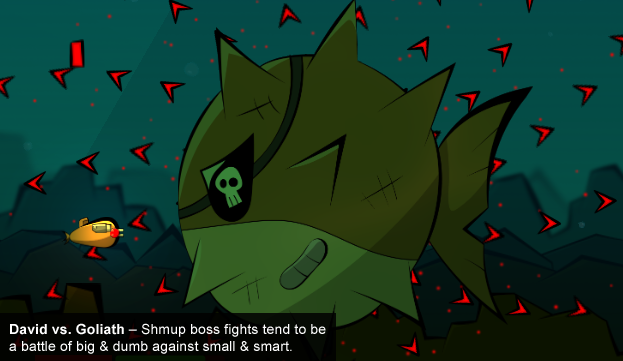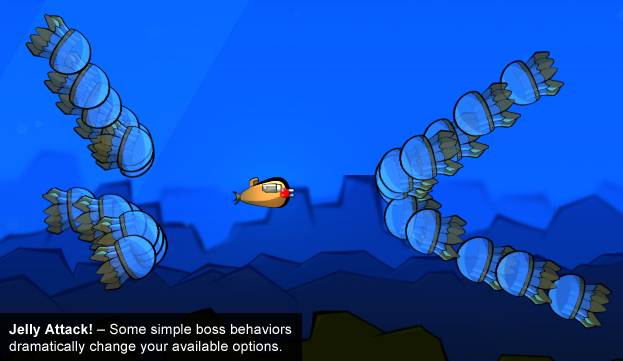-

Freshmaker: Revisiting Boss Design
Escape Industries is a small studio. Three of us, working odd hours around jobs and school, are attempting an ambitious project. For this reason, we spend a lot of time on two things. First, making tools to increase our productivity. Second, using design tricks to cram replayability into every nook and cranny. This article looks at one place where those two motives overlap: boss design.
Boss Design 101: Doing a Lot with a Little
Let’s get one thing out of the way: shoot-em-up bosses are dumb. Here’s the mind of a typical level boss:
- Use attack A.
- Use attack B.
- Use attack C.
- Goto 1 (repeat to infinity).
Now, I’m being a bit unfair here. Most games keep bosses a bit fresh by changing their attacks as they lose health or by randomizing their attack order. By and large, though, no decision-making goes into the attacks. They simply happen, and can be predicted.
Seems like a flaw, right? Don’t most game-makers tout the believability and cunning of their artificial intelligence? As it turns out, makers of games with high-performing AI have a very different set of motivations from shoot-em-up designers. For us, this boss idiocy is a central and saving feature. Our genre is, after all, famous for its insane difficulty¹. Can you imagine playing against bosses that were both super-strong and super smart? In a shoot-em-up, you’ll need to overcome wildly-overpowered monsters, yes, but once you figure them out, they’ll never trick you. Rather than finding a balance between brain and brawn, most developers go entirely one way: lots of bullets; no smarts.
¹ – For the uninitiated. Yes, you have to dodge all the bullets.
Boss Design 102: Doing Even More
Fingeance boss design differs just a bit. Our game has two extra considerations:
- It’s a party game. We’ve gone on record that this is a team-friendly game. Anyone can pick up the controller without being a drag on their team.
- It’s a roguelike. Everything is designed for short play sessions with oodles of replayability.
For those reasons, the difficulty in our toughest bosses can’t just come from a screen full of bullets. For newbies, bullet hell is intimidating. For veterans, it’s predictable. In Fingeance, we aim to have the bulk of boss difficulty come from their variety.
This past week, I’ve had a few days to work on our new boss creation system, which I’ve dubbed The Freshmaker². It gives us a framework to give bosses lists of behaviors, then add those behaviors to a queue. Each behavior has three components: a trigger, which adds it to the queue; an action, like shooting a cannon, which it performs when it reaches the top of the queue; and an end-trigger, which causes the boss to move to the next behavior in the queue.
² – The queue system reminds me of the way Mentos are stacked in a tube.
This system, which is still very new, should provide two benefits. First, we’ll be able to create a stable of pre-fabricated behaviors that we can experiment with on a new boss. That way, if we come up with some novel concept – say a boss that uses his breath to fling you into laser traps – we can scrape together a boss in minutes, using 90% recycled parts. The second major benefit is that our triggers are going to be quite flexible. Much of the time, behaviors will be queued at certain time intervals or when a boss falls below a certain amount of health. However, we’ll also be able to add triggers that react to player actions.
This last bit – boss reactions to player actions – has me excited. I look forward to building bosses that identify and react to various styles of play. Our goal is to make a game that rewards strategy and teamwork alongside traditional twitch gameplay, and I’d love it if this new boss structure helped make that a reality.
-


